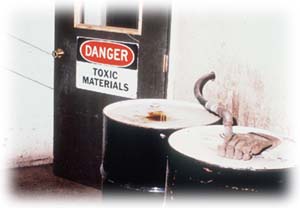Reaction and Interaction
Exposure to Multiple Chemicals
Depending upon the job you have, you may be exposed to more than one chemical at the same time. If you are, you need to be aware of possible reactions and interactions between them.
Reaction: A reaction occurs when chemicals combine with each other to produce a new substance. The new substance may have properties different from those of the original substances, and it could be more hazardous. For example, when household bleach and lye (such as a drain cleaner) are mixed together, highly dangerous chlorine gas and hydrochloric acid are formed.

Interaction: An interaction occurs when exposure to more than one substance results in a health effect different from the effects of either one alone.
- Synergism: One kind of interaction is called synergism, a process in which two or more chemicals produce an effect that is greater than the sum of their individual effects. For instance, carbon tetrachloride and ethanol (drinking alcohol) are both toxic to the liver. If you are overexposed to carbon tetrachloride and drink alcohol excessively, the damage to your liver may be much greater than the effects of the two chemicals added together.
- Potentiation: This interaction occurs when an effect of one substance is increased by exposure to a second substance which would not cause that effect by itself. For example, although acetone does not damage the liver by itself, it can increase carbon tetrachloride's ability to damage the liver.
Knowledge Check Choose the best answer for the question.
3-6. What is a chemical reaction in the context of workplace exposure?
You forgot to answer the question!
